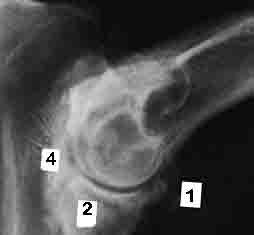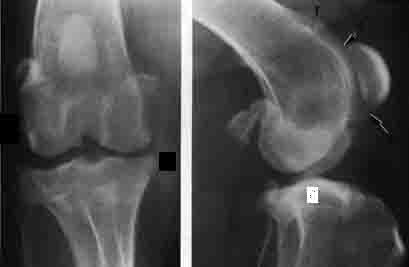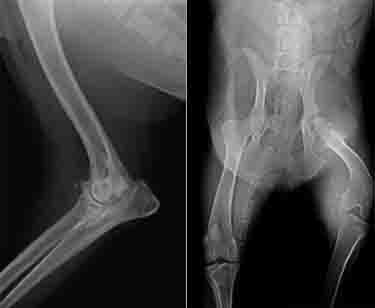Table of Contents
Overview of Symptoms | Diagnosis | Symptoms Questionnaire
Related Pages: Canine Arthritis Intro | Arthritis Medication | Arthritis Exercise | Vet Q&A
Summary:
"Signs and symptoms of arthritis in dogs can be measured against the checklist provided by the Arthritis Foundation. Signs are related to a dog's experience of pain and degrees of stiffness or lameness. Any symptoms tend to be more pronounced after sleep, in the morning hours, or in an environment that is damp and cold. The physical symptoms cause some dogs to behave differently, showing signs of irritability. Symptoms become more chronic as the arthritis progresses.
There are several diagnostic techniques available to veterinarians, including joint X-Rays and laboratory tests."
Overview: Arthritis Symptoms
Arthritis Foundation Symptom Checklist
The Arthritis Foundation (yes the same one as for people) has developed a checklist of dog arthritis symptoms that can help diagnose arthritis as early as possible.
If your dog shows one or more of these symptoms, he or she may be suffering from arthritis:
- Favoring a limb
- Difficulty sitting or standing
- Sleeping more
- Seeming to have stiff or sore joints
- Hesitancy to jump, run or climb stairs
- Weight Gain
- Decreased activity or less interest in play
- Being less alert
- Attitude or behavior changes (this list provided by Merial)
-- Decreased appetite
-- Lack of interest in food
-- Unusual barking
-- Uncharacteristic hiding
-- Lost interest in toys
-- Lost interest in playing
-- Not greeting family members with enthusiasm
-- Male dogs that squat to urinate (instead of lifting leg)
-- Female dogs that shake while squatting to defecate or urinate
Times Symptoms Are Often More Pronounced
- In the morning
- On colder, damp days
- After sleep
Clinical Signs of Osteoarthritis in Dogs |
||
|---|---|---|
| Joint Affected | Functional Impairment | Clinical Signs |
| Carpus (knee joint) |
Reluctance to jump down |
Pain on carpal joint flexion Loss of carpal flexion |
| Elbow Joint |
Reluctance to climb down stairs |
Pain on elbow joint flexion |
| Shoulder Joint |
Reluctance to jump down |
Plan on extension of the
shoulder joint |
| Tarsus (toe joints) |
Difficulties climbing stairs |
Tarsal joint effusion |
| Stifle joint |
Difficulties sitting straight |
Cranial weight shift Pain of stifle joint extension |
| Hip joint |
Difficulties climbing into car |
Pain of hip joint extension |
| Lumbosacral spine |
Difficulties squatting |
Cranial weight shift, ataxia Low tail carriage Fecal Incontinence Pain on direct or rectal palpation |
Diagnosis
Veterinarians will do a physical and an orthopedic exam. They will check the asymmetry of the limbs (to see if they look the same), swelling, heat, flex and extension of the limbs. The Vet will look for an altered gait, decreased range of motion, joint instability, pain, and listen to see if there are abnormal sounds coming from the joints. Bones will be closely examined, with a search for osteophytes (outgrowths from bones) that could be signs of arthritis or any other joint instability or deformity. If enough damage has occurred, a veterinarian will be able to hear a grating sound when the joint is manipulated.
The veterinarian will also ask for an assessment of the dog's quality of life such as the ability to:
- Jump up on a bed
- Run in the park or with members of the family
- Climb up stairs
- Retrieve a Frisbee
- Walk 1 mile in the neighborhood

If needed, your veterinarian will take X-Rays. Osteophytes, which are bone outgrowths, are seen in chronic cases of DJD on the elbow joints, shoulder, hip and stifle. If osteophytes are present, it does not mean that the dog definitely has osteoarthritis. It is only an indication of what occurs in joints that are affected by DJD or osteoarthritis.
X-Rays are used to detect changes in the joints including:
- joint fluid
- muscle decay
- muscle thickening
- joint membrane scarring
Stress X-rays can identify problems such as joint incongruities
and any underlying instability. A test called a Bone Nuclear
Scintigraphy can help to determine the location in dogs with hard to
detect cases of osteoarthritis.

Before reaching a diagnosis, a veterinarian will need to differentiate the diagnosis of arthritis from other diseases that can cause similar symptoms.
This includes:
- Neoplasms (cancerous tumors) including rare disorders such as chondrosarcoma and osteosarcoma. Synovial cell sarcoma is more common.
- Immune-mediated arthritis
Two lab tests are used to rule out these causes including a Coombs’ test for immune-mediated arthritis and Serum Titers for any infectious form of arthritis. Unlike Rheumatoid arthritis (immune-mediated arthritis), there are no specific lab results that definitely point to osteoarthritis as a diagnosis.
A biopsy of the synovial tissue is used to detect any neoplasia (cancerous tissue or tumors). Bacterial causes are ruled out with a bacterial culture of the synovial fluid.
After ruling out more serious causes, the veterinarian will often identify multiple diagnoses such as:
- Fibrosis or thickening of the joint capsule
- Sclerosis of the subchondral bone (tissue hardening)
- Erosion or Fibrillation of the articular cartilage

Questionnaire: Assess Arthritis Symptoms in Your Dog
Dog Arthritis Symptoms
Questionnaire
(PDF Download - Free & Printable)
Further Reading:
Joint Disorders in Dogs
Author: Merck
